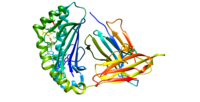
Photo from wikipedia
Abstract Some patients with hepatitis C virus (HCV) infections who fail to achieve sustained virological responses (SVRs) after interferon (IFN) therapy do not develop hepatocellular carcinoma (HCC). Risk stratification of… Click to show full abstract
Abstract Some patients with hepatitis C virus (HCV) infections who fail to achieve sustained virological responses (SVRs) after interferon (IFN) therapy do not develop hepatocellular carcinoma (HCC). Risk stratification of these patients may help identify those who would benefit most from treatment with direct-acting antivirals (DAAs). A total of 552 HCV-infected patients with non-SVR status were enrolled. Laboratory data before and after IFN treatment were analyzed to determine the relationship of changes in serum markers with development of HCC during the 7-year study period. HCC developed in 93 patients. The risk factors for HCC were pre-existing liver cirrhosis, low hemoglobin level at baseline, low pretreatment platelet count, high post-treatment alpha-fetoprotein (AFP) level (≥15 ng/mL), and high post-treatment Fibrosis 4 (FIB4) index (>3.25). For patients without pre-existing cirrhosis, those with high post-treatment AFP level and FIB4 index had the highest risk of HCC (1 year: 6.7%; 3 years: 10.9%; 5 years: 29.7%), followed by those with high post-treatment AFP level and low post-treatment FIB4 index (5 years: 25%), and those with low post-treatment AFP level and high post-treatment FIB4 index (1 year: 3.7%; 3 years: 5.2%; 5 years: 10.6%). The risk was even lower for patients with low post-treatment AFP level and FIB4 index (1 year: 0%; 3 years: 0.4%; 5 years: 2.5%). None of the patients with FIB4 indexes consistently below 1.45 developed HCC. The combined use of post-treatment AFP level and FIB4 index was useful for risk stratification of HCV-infected patients with non-SVR status after IFN therapy. These data may help clinicians to identify patients who most urgently need DAA treatment.
Journal Title: Medicine
Year Published: 2017
Link to full text (if available)
Share on Social Media: Sign Up to like & get
recommendations!